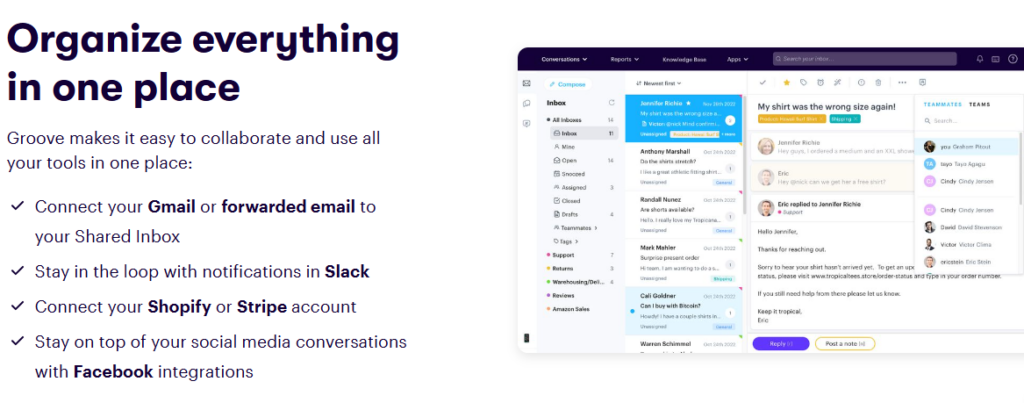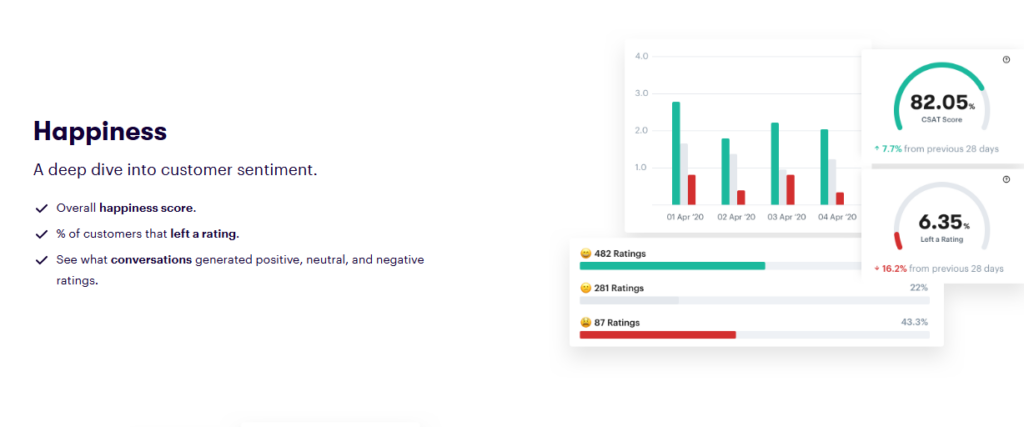You’ve poured your heart and soul into creating a product you’re proud of. But lately, you’ve noticed a troubling trend. Your customers aren’t as engaged as they used to be. And your poor support team? They’re drowning in a sea of tickets.
Success isn’t just about having a killer product. It’s about providing exceptional experiences at every touchpoint. Thriving businesses anticipate customer needs, provide personalized support, and make each interaction count.
So how do you give your small business a competitive edge? That’s where intelligent customer experience (ICX) comes in handy.
What Is Intelligent Customer Experience?
Ever wondered how some businesses seem to know exactly what their buyers need, sometimes even before those buyers do? That’s intelligent customer experience in action.
Simply put, ICX is a new way to improve how your business interacts with customers. It uses smart technology and consumer data to create personalized experiences that are efficient and effective.
ICX helps you predict what customers need, and solve problems before they happen. This makes things easier for buyers, whether they’re using your website, reaching out via social media, or talking to your support team.
What else? Intelligent customer experience is crucial because it:
- Boosts customer satisfaction through personalized and efficient interactions across all touchpoints. This makes buyers feel understood and valued.
- Gives businesses a competitive edge by meeting high customer expectations for quick and seamless service.
- Increases efficiency by automating routine tasks and providing instant responses, allowing you to handle more interactions effectively without increasing staff.
- Provides valuable insights from customer data, which enable better decision-making and continuous service improvements that are tailored to customer preferences.
The Principles of Intelligent Customer Experience
So, what makes ICX “intelligent”?
Here are the key principles that form the foundation of ICX:
- Customer-centricity. At its core, ICX puts the customer first. Every decision and strategy revolves around understanding and meeting buyers’ needs.
- Data-driven insights. ICX leverages data to gain a deeper understanding of customer behaviors, preferences, and pain points. This insight forms the basis for all interactions.
- Personalization. One size doesn’t fit all in ICX. It’s about tailoring experiences to individual needs and preferences.
- Proactive approach. Instead of just reacting to customer issues, ICX aims to anticipate and address potential problems before they occur.
- Seamless integration. ICX ensures a consistent experience across all customer touchpoints, whether online or offline.
- Continuous improvement. An intelligent customer experience is never static. It evolves based on ongoing feedback and changing customer needs.
How To Implement Intelligent CX for Your Small Business
All of the above might sound like a lot. How do you actually make it happen for your small business? Let’s break the ICX process down into manageable steps that won’t overwhelm you or your budget.
Step 1: Understand Your Customers Deeply
First things first: You can’t create an intelligent experience if you don’t know who you’re creating it for. This step is all about getting to know your customers like they’re your best friends.
Why is this so crucial? Well, imagine trying to buy a birthday gift for someone you’ve never met. Pretty tough, right? The same goes for your business. If you don’t understand your customers’ needs, preferences, and pain points, you’re just shooting in the dark with your products and services.
To achieve this deep understanding, you’ll need to develop comprehensive customer personas. These are detailed profiles that represent distinct segments of your customer base, each with unique characteristics, needs, and behaviors.
Here’s how to create effective personas:
- Gather the data. Use surveys, feedback forms, and purchase history to collect information about your customers. What are their age ranges? What do they buy often? What problems are they trying to solve?
- Look for patterns. Start grouping customers with similar characteristics. Maybe you attract a lot of busy parents who value convenience, or tech-savvy millennials who love trying new features.
- Create detailed profiles. For each group, create a persona. Give them a name, a backstory, and specific traits.
- For example: “Maria, a 35-year-old working mom who values time-saving solutions and shops mostly on her smartphone during her commute.”
Whenever you’re making decisions about your products, services, or marketing, think about how each persona would react.
Would “Maria” find this new feature helpful? Would she prefer an email or a text message for updates? This lets you tailor your communications, predict needs, and solve problems more effectively.
Step 2: Embrace Omnichannel Support
Omnichannel support means providing a consistent experience across all communication channels—email, chat, social media, phone, etc.
Unlike multichannel support, which treats each channel as a separate silo, an omnichannel approach prioritizes a unified view of the customer journey. You can meet customers where they are, offering a cohesive experience regardless of how they choose to reach out.
This approach also improves your team’s efficiency, by centralizing information and streamlining workflows. Here’s how you can get started:
- Map your customer journey. Identify all the touchpoints where customers interact with your business.
- Invest in unified technology. Look for a help desk solution that integrates all your communication channels into a single platform.
- Our small business support helpdesk, Groove, gives you a unified inbox that consolidates messages from various channels. This makes it easier for your team to manage interactions efficiently.

- Create a shared knowledge base. Build a centralized repository of information that your team can access, regardless of the channels they’re using to communicate with customers.
- Groove’s knowledge base feature is also helpful here! It allows you to create and organize helpful articles that your team and/or customers can access.
- Train your team. Ensure that your support team is comfortable navigating between different channels, and understands how to maintain a consistent voice across all platforms.
In addition, consider implementing chatbots or automated responses for FAQs. This provides instant support, freeing up your team to handle more complex issues.
Step 3: Personalize, Personalize, Personalize
Think of personalization in CX as the difference between a generic mass email, and a thoughtful message that addresses the customer by name and references their recent purchase. It’s how you tailor your interactions, offerings, and content to meet the specific needs and preferences of individual buyers.
While it’s common for consumers to be bombarded with generic messages and offers, personalization cuts through the noise and makes them feel valued and understood. This leads to stronger relationships, increased loyalty, and ultimately, better business outcomes.
So, how can you make personalization work for your business, while staying efficient? You can:
- Leverage analytics. Use the customer data you’ve collected to gain insights into behavior patterns and preferences.
- Segment your customers. Group buyers based on common characteristics, behaviors, or needs. This could include factors like purchase history, engagement level, and demographic information.
- Tailor support responses. Use your customer segments to customize your support responses. For instance, a tech-savvy buyer might appreciate more detailed technical explanations, while others may prefer simpler language.
- Personalize offers and recommendations. Based on a customer’s purchase history or browsing behavior, offer deals that align with their interests.
- Use dynamic content. In your emails or on your website, use dynamic content that changes based on who’s viewing it. This could be as simple as addressing the customer by name, or as complex as showing different product recommendations.
- Implement behavioral triggers. Set up automated messages or actions based on specific customer behaviors. For example, send a follow-up email if a customer abandons their shopping cart.
While you’re at it, don’t forget that your personalization efforts should be consistent across all channels, from email to social media to in-person interactions. If a customer recently made a purchase, your support team should be aware of it when that customer reaches out, regardless of channel.
Step 4: Implement Predictive Analytics and Proactive Support
One cornerstone of ICX is the ability to anticipate customer needs and address them proactively. Predictive analytics allows businesses to foresee potential issues or opportunities in the customer journey.
By addressing these upfront, you can enhance customer satisfaction, reduce churn, and create a more positive overall experience. It shifts your customer service from reactive to proactive, and demonstrates that you value your customers’ time and needs.
Here’s how to implement predictive analytics and proactive support:
- Collect and analyze historical data. Gather data from past customer interactions, purchases, and behaviors. This forms the foundation for predictive models.
- Use AI to predict customer needs. Leverage machine learning algorithms to analyze historical data and identify patterns. For example, AI can use a collaborative filtering algorithm to suggest products based on similar customers’ preferences.
- Identify key triggers. Determine specific events or behaviors that indicate a customer might need support or be at risk of churning.
- Create proactive outreach strategies. Develop automated workflows that trigger personalized outreach based on predicted needs or issues.
- Utilize predictive maintenance. For product-based businesses, use data to predict when a product might need maintenance or replacement, and reach out to customers preemptively.
- Implement smart notifications. Set up a system that sends personalized notifications or recommendations based on predicted customer needs or interests.
- Train your team. Ensure that your customer service team understands how to interpret and act on predictive insights effectively.
- Measure impact. Track metrics like reduction in support tickets, increase in customer satisfaction scores, and changes in churn rate to gauge the effectiveness of your proactive approach.
Step 5: Build a Customer Feedback Loop
Now it’s time to ensure that your efforts continue to evolve and improve over time. The key? Setting up a robust customer feedback loop.
Think of this as creating a direct line between your customers’ thoughts and your business’ decisions. It’s about constantly listening, learning, and adapting based on what your buyers are telling you.
Having a customer feedback loop is important for your ICX strategy, because it transforms your approach from a one-time implementation into a living system that grows with your business and your customers’ needs.
Let’s dive into how you can set this up for your small business:
- Gather feedback systematically. Set up multiple channels for customer feedback. This could include post-interaction surveys, social media monitoring, regular check-in calls with key customers, and feedback forms on your website.

- Analyze and prioritize. Schedule regular sessions to review the collected feedback. Look for common themes or recurring issues. Based on frequency and impact, create a prioritized list of areas for improvement.
- Act on insights. For each priority issue, develop and implement a plan of action. This could involve changes to your product, service, or internal processes. Start with manageable changes that can make a big impact.
- Close the loop. Inform customers about the changes you’ve made based on their feedback. This shows that you value their input and are committed to improving their experience.
- Monitor and iterate. Keep track of how your changes impact CX, using simple metrics like customer satisfaction scores and repeat purchase rates. Based on the results, refine your approach and continue the cycle of gathering feedback and making improvements.
Take Action on ICX Today, And Promote Long-Term Success
Intelligent customer experience is more than a trend. It’s the future of online business. By implementing ICX, your team can deliver personalized and efficient support that rivals what larger companies offer, creating loyal customers and driving growth.
The businesses that embrace ICX now will be best positioned for long-term success. Don’t let yours get left behind!
With Groove, you’ll have a powerful ally in your ICX journey. Our intuitive platform helps you centralize customer data, automate interactions, and gain valuable insights—and a lot more.
Start your free 7-day trial with Groove, and make a move towards an intelligent, customer-centric future.



